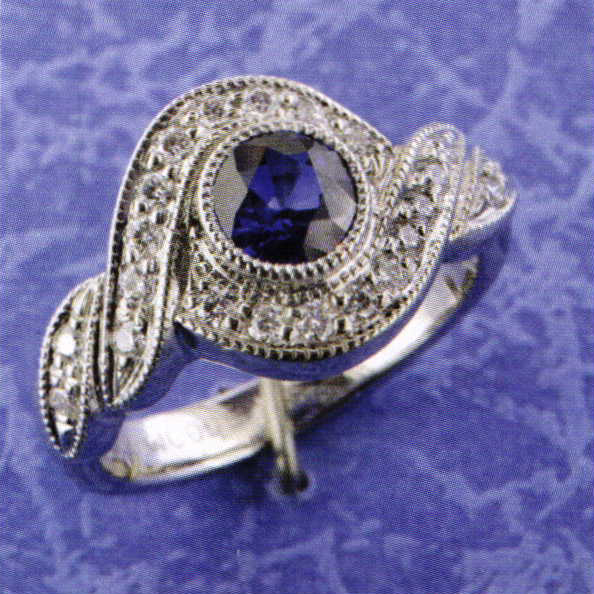Bezel Setting Using a Lathe
4 Minute Read
Bezel setting the center sapphire is normally pretty straight-forward, but I would like to share a few tricks that have helped me improve the outcome. Please follow along as I bezel set this sapphire using a lathe or a watch-maker's lathe.
Recently this design for a sapphire ring came to my bench. My instructions were to carve a wax model and have the mounting cast in 14 karat white gold. The ring was to have twenty-two .01 ct. diamonds bead and bright set around the sides and this .69 ct. round sapphire bezel set in platinum (for durability) and mounted as the center stone.
This watch-maker's lathe was made by the Derbenshire Lathe Company sometime during the 1940's, and was purchased from the U.S. Navy as surplus. It was originally used by machinists to manufacture the small parts that went in the mechanical navigation equipment of warships. Throughout its history this lathe has been kept in great shape and it's the prefect tool to help me bezel set that sapphire. In case you're interested. I've seen similar lathes sell for about $400 on EBay. If you get the accessories, a reversible motor and good selection of collets your total cost may be close to $700. It's a good investment in a great old tool.
Bench jewelers arc accustomed to working with flexshafts that hold items in three-jaw chucks. Lathes use very precise, interchangeable, collets to hold parts. My platinum tube is being inserted into a number 59 collet that will, in tum, screw into the headstock of the lathe. The openings in lathe collets range in size from .01mm to 8 mm and are graduated in .01 mm increments.
These collets are the expensive part of a lathe as each one can cost $15 or more. You don't need to have all ninety of the collet sizes, but a good selection of forty different sizes would work well.
This lathe is a high quality machine. It has the added benefit of having a tailstock in which I can place a second collet to hold various tools. The tailstock seen here on the right is holding the setting bur. The headstock which holds the tubing spins while the bur stays stationary. As you can imagine a very precise seat can be cut using a set-up like this.
The finished ring came out well and my customer liked it very much. Lathe setting is much more than just a trick or gimmick. The completed work is very clean and even. This setting method works beautifully for making simple tube set stone earrings and pendants. It is a fast way to set stones and it's a lot of fun. I can guarantee that once you try it you'll be changing your designs to incorporate tube set stones.
For those of you keeping track, this ring took just over 16 hours to complete.
You assume all responsibility and risk for the use of the safety resources available on or through this web page. The International Gem Society LLC does not assume any liability for the materials, information and opinions provided on, or available through, this web page. No advice or information provided by this website shall create any warranty. Reliance on such advice, information or the content of this web page is solely at your own risk, including without limitation any safety guidelines, resources or precautions, or any other information related to safety that may be available on or through this web page. The International Gem Society LLC disclaims any liability for injury, death or damages resulting from the use thereof.
The All-In-One Jewelry Making Solution At Your Fingertips
When you join the Ganoksin community, you get the tools you need to take your work to the next level.
Trusted Jewelry Making Information & Techniques
Sign up to receive the latest articles, techniques, and inspirations with our free newsletter.
